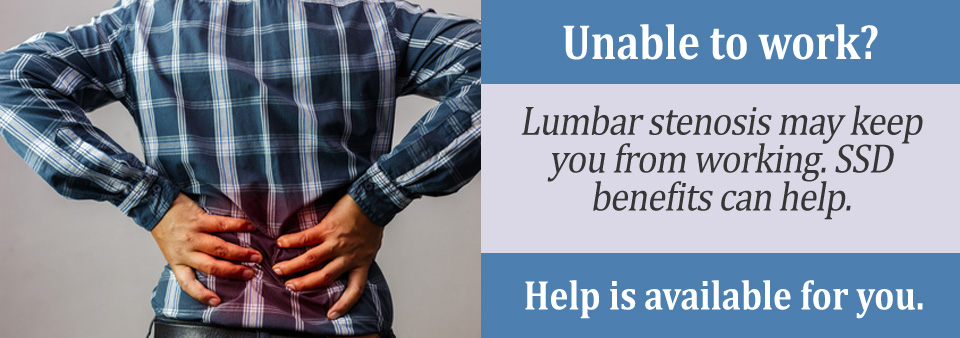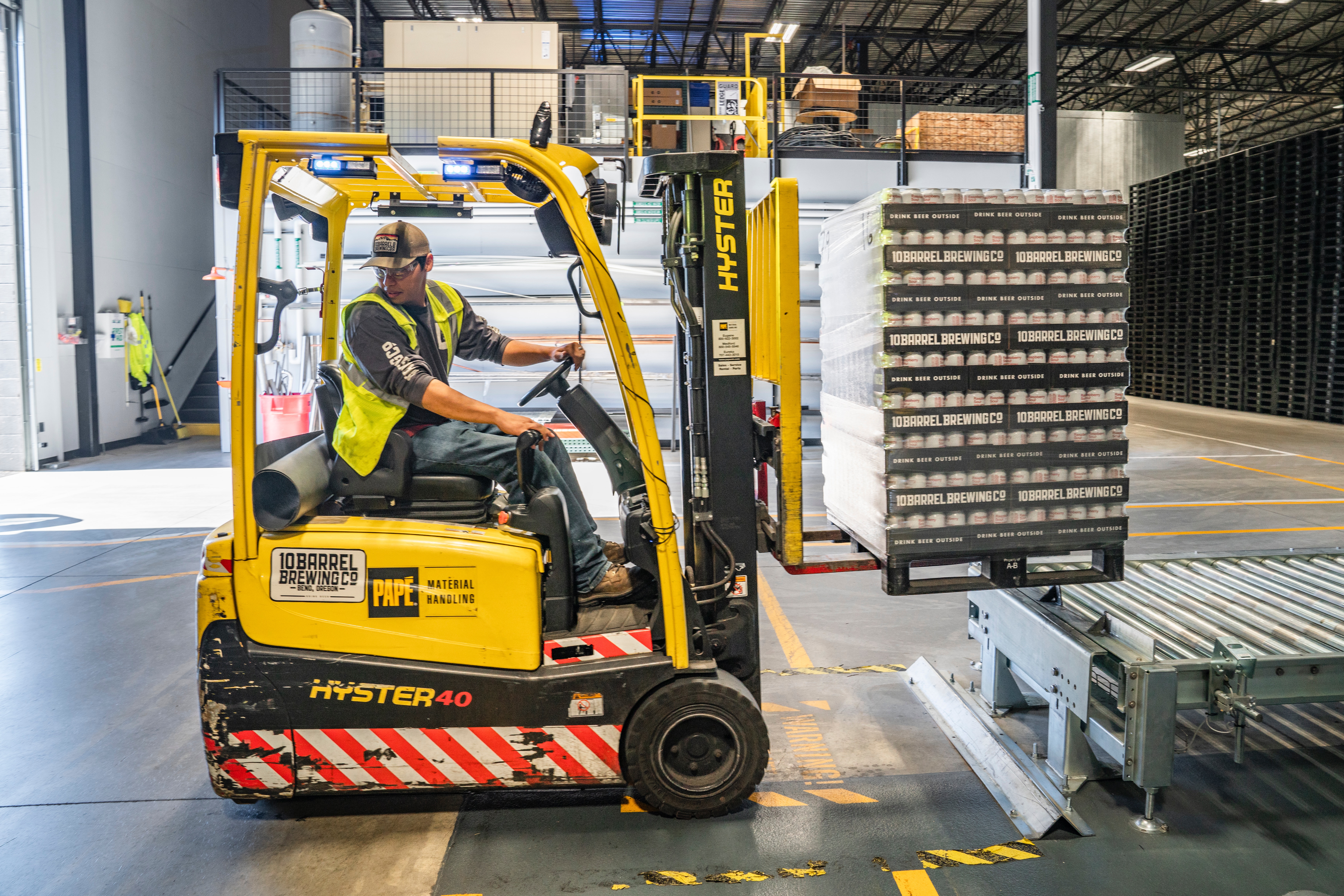Lumbar Spinal Stenosis (LSS) is a relatively common problem affecting over 400,000 people a year in the United States.
Lumbar spinal stenosis is generally diagnosed in people over the age of 50, and the symptoms of the condition vary from person to person. While some people have intermittent pain or numbness when walking, others are so severely impacted that they require surgery.
Lumbar spinal stenosis is one of the spine disorders that qualify for disability. If you have lumbar spinal stenosis and it is preventing you from earning a gainful living, there could be financial help available to you. The Social Security Disability Insurance (SSDI) program was created to assist those who have become disabled due to a condition such as lumbar spinal stenosis.
You may be eligible to receive $3,345 each month. Fill out a Free Disability Evaluation today!
What Exactly Is Lumbar Spinal Stenosis?
Lumbar spinal stenosis is a condition that causes the spinal canal to narrow, which compresses the spinal cord and nerves. The narrowing occurs in the lower part of the back (the lumbar region). The most common cause of lumbar spinal stenosis is osteoarthritis or degenerative disc disease, which occurs while aging.
The most common symptoms experienced with LSS are pain and numbness in the lower back and legs, which worsens when walking. Some people also experience weakness in the legs as well. For many people with LSS, the symptoms come and go.
Treatment for lumbar spinal stenosis depends on its severity. Physical therapy, lumbar traction, chiropractic adjustments, anti-inflammatory medications, and steroid injections are some of the nonsurgical options. Surgeries such as a laminectomy or a spinal fusion may also be considered.
Is Spinal Stenosis a Permanent Disability?
Spinal stenosis can become permanent if it does not respond to treatments. If you have spinal stenosis, and it is serious enough that you are unable to work or perform normal day-to-day activities, it may result in permanent disability and you might want to apply for Social Security disability benefits.
Spinal stenosis is located in the Social Security disability blue book under disorders of the spine. The Blue Book is the informal name to the Disability Evaluation Under Social Security which is the list of disabilities/impairments that could qualify for Social Security disability benefits.
The SSA defines a disability as the inability to engage in any substantial gainful activity (SGA) by reason of any medically determinable physical or mental impairment(s) which can be expected to result in death or which has lasted or can be expected to last for a continuous period of not less than 1 year.
If you have spinal stenosis and you believe that it is permanent and it will force you to be out of work for at least 1 year, then you could be considered disabled by the SSA and could qualify for disability. 
What Can I Expect?
There is a range of symptoms that you might experience when you have lumbar spinal stenosis, and they all might affect your ability to work differently.
Lumbar spinal stenosis can be found in the Musculoskeletal system section (1.04) of the Social Security Administration’s (SSA) “Blue Book.” This manual lists a variety of conditions, as well as the requirements needed to qualify for benefits under these conditions.
According to the Blue Book, here are some signs that your lumbar spinal stenosis might help you qualify for disability benefits:
Lumbar spinal stenosis sometimes causes pseudo claudication, which is pain in your legs caused by compression of your nerve roots. If you experience pseudo claudication that makes it difficult to walk or move around, you will be considered for benefits from the SSA.
Chronic pain, numbness, or weakness in your legs could make tasks like walking or driving very difficult. You may need to use a cane, walker, or wheelchair to get around. Some people require assistance getting in or out of a car. If you have difficulty with mobility issues, you may be eligible for financial aid.

If you require surgery as a result of lumbar spinal stenosis, and you have difficulty recovering from surgery or worsening symptoms after surgery, you may qualify for disability benefits.
If your doctor puts you on medications for lumbar spinal stenosis, you may experience some side effects that may affect your quality of life.
NSAIDS used to reduce inflammation around the lumbar area may cause severe stomach problems such as heartburn, acid reflux, nausea, and in severe cases, kidney problems and bleeding from the lining of your stomach.
In some cases, steroid injections are given in the epidural space of the spinal canal. While steroids help to relieve swelling, they can cause side effects such as non-positional headaches, anxiety, fever, high blood sugars, and decreased immunity.
Can You Work with Spinal Stenosis?
Since spinal stenosis puts pressure on nerves that run through the spine, which could cause neck and lower back pain, it could impact your ability to perform your job before you had this condition.
For example, let’s say you work in a warehouse and part of your job function is to carry boxes to the trucks, if your spinal stenosis is so severe that you are unable to life boxes, then you could be able to qualify for Social Security disability benefits.
Another example of spinal stenosis impacting your ability to work is say you are working at a desk job sitting in front of a computer all day and your spinal stenosis is so severe in your neck that you are having difficulties performing the duties of your job, then you could qualify for Social Security disability benefits.
If your spinal stenosis is so severe that you are unable to perform the normal duties of your job and you cannot work anymore, you could qualify for Social Security disability benefits.
What Benefits Can You Claim with Spinal Stenosis?
If you have spinal stenosis, most likely than not the benefits that you will be able to claim for that condition is Social Security Disability Insurance (SSDI).
SSDI is a disability program administered by the SSA that gives benefits to those with disabilities or severe ailments, like spinal stenosis who at one point could work, but because of their condition they can no longer work anymore.
The first thing when applying for SSDI benefits with spinal stenosis is that you have to meet the medical listing outlined in the Blue Book. As stated above, spinal stenosis is located in the Blue Book in section 1.04 under disorders of the spine.
The listing in the Blue Book states that spinal conditions resulting in compromise of a nerve root (including the cauda equina) or the spinal cord with:
- Lumbar spinal stenosis resulting in pseudoclaudication, established by findings on appropriate medically acceptable imaging, manifested by chronic nonradicular pain and weakness, and resulting in inability to ambulate effectively
If your medical records and other paperwork help you match the listing in the Blue Book that is one part of being able to qualify for Social Security Disability Insurance (SSDI).
The second part of being able to qualify for SSDI benefits is having enough work credits to qualify as SSDI is for those who could at one point work, but now cannot because of their condition.

You earn work credits throughout your work history. Each year that you earn wages and pay FICA taxes into the Social Security system, you receive work credits. You can receive a maximum of 4 work credits per year that you have worked.
In 2020, a worker must earn $1,410 to earn one work credit, every case is different, but you usually need up to 20 work credits in order to qualify for SSDI. If your spinal stenosis matches the Blue Book listing and you have enough work credits, then you may be able to claim SSDI benefits with spinal stenosis.
Do I Qualify for Benefits?
To be eligible for Social Security benefits for lumbar spinal stenosis, your medical records will need to show that your symptoms are severe enough to prevent you from working at a level that would support you.
Additionally, your illness needs to be expected to be disabling for at least 12 months. Unfortunately, lumbar spinal stenosis is unlikely to improve over time.
Considering applying for Social Security disability benefits but not sure how much you’ll earn per month? Our SSDI Calculator can help you determine how much you’ll receive from the SSA before you file for disability
What Information Will I Need to Provide?
When applying for Social Security benefits for lumbar spinal stenosis, medical documentation is critical. You should obtain the following:
- Confirmation of your diagnosis of LSS from a doctor, including a full examination report of the spine. The report should include information about your gait, range of motion, motor and sensory abnormalities, and any symptoms of muscle spasm. Your physician should note your ability to move, such as getting on and off the table, as well as your prognosis.
- X-rays, MRIs, CT scans, or other imaging results that may help to confirm your diagnosis of lumbar spinal stenosis. If your MRI can demonstrate joint space narrowing or bone fusion, you may have a higher chance of being approved for benefits.
- Surgical notes, if applicable.
- Notes from any other specialists, physical therapists, or other health care providers that are involved in your care.
You should speak with your doctor’s office, hospital, or other health-care providers if you are missing any of the above medical reports. The more medical evidence that you have on your side, the better your chances of receiving SSDI benefits for lumbar spinal stenosis.
What’s Next?
If you have lumbar spinal stenosis and you believe that you may qualify for Social Security benefits, you should contact a disability advocate or lawyer in your area. When your health is suffering, it can be difficult to know where to turn or what to do next.
A qualified attorney can help you navigate the Social Security application process, leaving you time to focus on what’s most important: your health.
